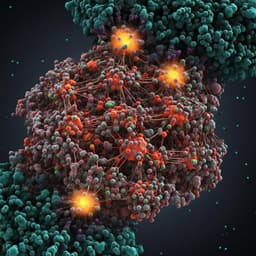
Biology
Synthetic anaplerotic modules for the direct synthesis of complex molecules from CO₂
C. Diehl, P. D. Gerlinger, et al.
This study, conducted by Christoph Diehl, Patrick D. Gerlinger, Nicole Paczia, and Tobias J. Erb, explores innovative anaplerotic strategies that enhance a synthetic CO₂-fixation pathway. The effective design and implementation of these modules resulted in a remarkable carbon-positive synthesis of 6-deoxyerythronolide B, showcasing a leap forward in synthetic metabolic networks.
~3 min • Beginner • English
Introduction
Synthetic biology seeks to design biological parts and metabolic systems beyond those found in nature, including efficient CO2-fixation pathways. The CETCH cycle is a synthetic in vitro CO2-fixing network that operates with lower energy demand than the Calvin cycle and features highly efficient enoyl-CoA carboxylases/reductases. Despite these advantages, synthetic in vitro pathways typically lack the metabolic flexibility of natural networks and are often limited to a single output. For the CETCH cycle, the primary output is glyoxylate, and siphoning off core C3–C5 intermediates needed for biosynthesis would rapidly deplete acceptors and stall the cycle. The research question addressed here is whether incorporating anaplerotic reaction sequences can replenish core intermediates of the CETCH cycle while simultaneously enabling direct access to these metabolites for downstream synthesis. The goal is to create a flexible, continuously operating in vitro network that can convert CO2 into complex molecules by dynamically refilling intermediates as they are withdrawn for product formation.
Literature Review
The study builds on prior work designing synthetic CO2-fixation pathways and the CETCH cycle, which demonstrates higher energetic efficiency than natural photosynthesis. Natural metabolism uses anaplerotic routes (for example, pyruvate carboxylase, malic enzyme, glyoxylate cycle) to maintain flux in central pathways such as the TCA cycle. The authors also leverage established pathways and enzymes: the β-hydroxyaspartate cycle (BHAC) for glyoxylate assimilation to oxaloacetate, elements of the serine cycle to generate malate and acetyl-CoA, the reductive TCA and glyoxylate cycles to reach succinyl-CoA, the 3-hydroxypropionate cycle to regenerate propionyl-CoA, and the ethylmalonyl-CoA (EMC) pathway to provide crotonyl-CoA. For product benchmarking, they use DEBS, a well-characterized type I polyketide synthase that requires propionyl-CoA and methylmalonyl-CoA. Prior reports also inform enzyme selection (oxygen-tolerant aconitase, citrate synthase regulation properties), engineered propionyl-CoA carboxylase variants (Pcc*), and multicatalytic propionyl-CoA synthetase compartments. Together, this literature underpins the modular anaplerotic design and enzyme choices for robust, oxygen-tolerant, carbon-conserving in vitro operation.
Methodology
- Core network (Module 1, CETCH 5.5): The authors reconstituted an optimized CETCH cycle in vitro with modifications to previous versions: glycolate readout via glyoxylate reductase (irreversibly converting glyoxylate to glycolate) and a creatine phosphokinase-based ATP regeneration system (avoiding precipitation from polyphosphate). Reactions were typically started with propionyl-CoA, and enzyme concentrations were tuned (0.4–21 µM; 0.1–5 U ml−1). Performance was quantified as glycolate formation and CO2 fixed per acceptor molecule.
- Downstream conversion (Modules 2 and 3): To recycle glyoxylate into central metabolites, the β-hydroxyaspartate cycle (BHAC, Module 2) converted glyoxylate plus glycine into oxaloacetate via iminosuccinate, requiring careful tuning to avoid iminosuccinate hydrolysis (excess iminosuccinate reductase over dehydratase). Module 3 used serine cycle steps to transform oxaloacetate into malate (Mdh), then malyl-CoA (Mtk and Mcl), and ultimately acetyl-CoA plus glyoxylate (via Mcl), enabling further conversion and re-entry into Module 2. Enzyme activities were 0.5–8 U ml−1.
- Coupling Modules 1–3: Initial coupling produced acetyl-CoA, improved substantially by switching to phosphocreatine ATP regeneration. To prevent acetyl-CoA buildup and reverse condensation to malyl-CoA, acetyl-CoA was withdrawn by carboxylation to malonyl-CoA using an engineered propionyl-CoA carboxylase (Pcc*), increasing overall productivity.
- Anaplerotic Modules 4a–d design: Thermodynamically feasible, oxygen-tolerant sequences were chosen to feed central metabolites back into Module 1 intermediates.
- Module 4a (reductive TCA): From malate via fumarase (Fum) to fumarate, fumarate reductase (Frd) to succinate, and succinate-CoA ligase (Scs) to succinyl-CoA. A soluble, NADH-dependent Frd from Trypanosoma brucei was used but required careful minimization due to H2O2 generation and futile NAD(P)H oxidation; catalase was included.
- Module 4b (glyoxylate cycle): Citrate synthase (Synechocystis Cit) condenses acetyl-CoA with oxaloacetate to citrate, aconitase (AcnA) to isocitrate, and isocitrate lyase (Icl) to glyoxylate and succinate (converted to succinyl-CoA by Scs). Competition for oxaloacetate between Mdh and Cit was tuned by lowering Mdh activity.
- Module 4c (3-hydroxypropionate bi-cycle segment): Pcc* converts acetyl-CoA to malonyl-CoA; a bifunctional malonyl-CoA/malonate semialdehyde reductase reduces to 3-hydroxypropionate (3-OHP); propionyl-CoA synthetase (Pcs) within a multicatalytic nanocompartment converts 3-OHP to propionyl-CoA. Adenylate kinase (Adk) was added to recycle AMP from Pcs. This module has the strongest thermodynamic drive and consumes three ATP and three NADPH per cycle.
- Module 4d (partial EMC pathway): Acetyl-CoA acetyltransferase (Aat) to acetoacetyl-CoA, acetoacetyl-CoA reductase (Aar) to 3-hydroxybutyryl-CoA, and a β-hydroxybutyryl-CoA dehydratase (Bbd) to crotonyl-CoA, which re-enters Module 1 upstream of carboxylation. Free CoA modulated Aat activity; system-level CoA titrations were performed.
- Prototyping and optimization:
- Module 1 optimization quantified CO2 fixation efficiency and glycolate output.
- Module 2 validation measured malate formation from varying glyoxylate concentrations at limiting glycine to confirm amino group recycling.
- Modules 1–3 optimization assessed acetyl-CoA and malonyl-CoA formation with different ATP regeneration systems and Pcc*.
- Module 4a: Frd dosing (0.01–0.1 mU ml−1) optimized to minimize futile NAD(P)H oxidation; Frd added last to assays.
- Module 4b: Mdh activity titration identified low Mdh (0.8 U ml−1) as optimal to allow Cit flux.
- Module 4c: Tested with and without Adk to boost ATP recycling; time courses measured methylmalonyl-CoA accumulation.
- Module 4d: Systematic variation of free CoA (0.25–2.5 mM) assessed impacts on Aat and network output.
- Benchmark product synthesis (Module 5, DEBS): The DEBS polyketide synthase module consumes propionyl-CoA and six methylmalonyl-CoA with six NADPH to produce 6-DEB. 6-DEB was quantified by calibrated HPLC-MS, using NADPH consumption to validate stoichiometry and generate standard curves. Time courses were run for coupled Modules 1–3 with each of 4a–d, with and without DEBS, starting typically from glyoxylate (for anaplerotic setups) or propionyl-CoA (controls). CoA esters, glycolate, malate, and 6-DEB were measured via LC-MS/HPLC-MS with established methods.
Key Findings
- Optimized CETCH (Module 1, CETCH 5.5): From 100 µM propionyl-CoA, produced 381 ± 6.6 µM glycolate in 90 min, corresponding to 7.6 ± 0.2 CO2 fixed per acceptor and 3.8 cycle turnovers, a 1.4-fold improvement over prior setup.
- BHAC validation (Module 2): With fixed 250 µM glycine and up to 1,000 µM glyoxylate, malate yields approached theoretical maxima; assays indicated ~90% amino group recycling at high glyoxylate, confirming multiple BHAC turns.
- Coupling Modules 1–3: Switching to creatine phosphokinase ATP regeneration increased acetyl-CoA to 260 µM in 3 h, though acetyl-CoA plateaued and decreased due to reversible malyl-CoA formation. Diverting acetyl-CoA to malonyl-CoA via Pcc* raised malonyl-CoA to >450 µM in 3 h (>4.5 cycle turnovers).
- Module 4a (rTCA feedback): Optimal low Frd (0.01 mU ml−1) yielded the highest methylmalonyl-CoA (49 ± 18.9 µM at 90 min from 250 µM glyoxylate); higher Frd or more formate did not improve yields.
- Module 4b (glyoxylate cycle feedback): Mdh controls oxaloacetate allocation; high Mdh (7.9 U ml−1) led to acetyl-CoA accumulation and only 6 µM methylmalonyl-CoA in 2 h, whereas low Mdh (0.8 U ml−1) enabled ~60 µM methylmalonyl-CoA in 2 h.
- Module 4c (3-OHP segment feedback): From 250 µM glyoxylate, formed up to 490 µM methylmalonyl-CoA in 2 h; adenylate kinase addition increased yield by ~30% at 2 h and exceeded 700 µM by 4 h.
- Module 4d (partial EMC feedback): Free CoA strongly affected Aat; despite inhibition at 1 mM CoA in isolation, the full system at 1 mM CoA gave the highest methylmalonyl-CoA (129 µM) versus 93 µM at 2.5 mM CoA.
- Carbon conversion efficiencies to methylmalonyl-CoA (from 250 µM glyoxylate, peaking ~8 h): ~110% (Modules 1–3+4a), ~90% (1–3+4b), ~400% (1–3+4c), ~60% (1–3+4d). Thus modules 4a and 4c were carbon-positive under these conditions.
- 6-DEB synthesis from CO2: With DEBS included, 6-DEB was produced only when anaplerotic modules were present. Yields: 6.0 ± 0.2 µM (4a), 2.8 ± 1.0 µM (4b), 31.9 ± 1.6 µM (4c). Module 4d produced methylmalonyl-CoA without DEBS but failed to yield detectable 6-DEB in its presence. Controls (Module 1 ± DEBS without anaplerosis) produced no 6-DEB and showed ~70% reduction in glycolate, indicating DEBS drained intermediates and stalled the core cycle.
- Carbon-positive 6-DEB production: Modules 1–3+4c+DEBS achieved 172% effective carbon conversion to 6-DEB, directly from CO2, operating up to 54 enzymatic steps in vitro. Yields were comparable to isolated DEBS supplied with 0.8 mM propionyl-CoA and 1.0 mM methylmalonyl-CoA (39.1 ± 0.3 µM).
Discussion
The study demonstrates that embedding anaplerotic feedback into a synthetic in vitro network restores and maintains core metabolite pools while enabling their diversion to product synthesis. Without anaplerosis, siphoning C3–C5 intermediates from the CETCH cycle stalls CO2 fixation and precludes complex product formation. By designing oxygen-tolerant, thermodynamically favorable anaplerotic routes that re-enter the CETCH cycle at strategic nodes, the authors achieved continuous operation and product formation. Module 4c outperformed others due to its strong thermodynamic driving force and direct supply of propionyl-CoA, which is only two steps from methylmalonyl-CoA, minimizing additional bottlenecks. In contrast, modules 4a and 4b re-enter as succinyl-CoA and require many more steps, increasing susceptibility to kinetic limits and cofactor imbalances (e.g., Frd’s NAD(P)H/oxygen side reactivity depleting redox pools). The work highlights the importance of balancing propionyl- and methylmalonyl-CoA pools, especially in the presence of DEBS, which can drain intermediates and impede the core cycle if not countered by anaplerotic replenishment. The capacity of Pcc* in module 4c to carboxylate both acetyl-CoA and propionyl-CoA provides a dynamic response to cofactor availability (ATP vs. NADPH), acting as a molecular rheostat. Overall, integrating anaplerosis enables carbon-positive conversion of CO2 to a complex polyketide at yields comparable to an isolated PKS while running a 50+ enzyme network, underscoring anaplerosis as a foundational design principle for complex synthetic metabolic systems.
Conclusion
The authors designed and implemented four anaplerotic modules to replenish core intermediates of the CETCH CO2-fixation cycle, enabling direct access to C3–C5 CoA thioesters for biosynthesis. Coupling these with modules converting glyoxylate to central metabolites and with DEBS allowed carbon-positive synthesis of 6-deoxyerythronolide B from CO2 in vitro, operating up to 54 enzymatic reactions with product yields comparable to isolated DEBS. Among the feedbacks, the 3-hydroxypropionate-based module (4c) was most productive, reflecting both thermodynamic advantage and favorable re-entry points. This work establishes anaplerosis as a key design strategy to enhance flexibility, robustness, and productivity of synthetic in vitro metabolic networks and opens avenues to produce other complex molecules (polyketides, polymers) directly from CO2. Future research should focus on protein engineering to remove enzymatic bottlenecks (e.g., oxygen-sensitive or side-reactive steps), optimized cofactor management, dynamic control layers (allostery, molecular purge valves), spatial organization or compartmentalization, and coupling to energy modules (e.g., light-driven systems) to approach the regulatory sophistication of living metabolism.
Limitations
- Sensitivity to enzyme selection and tuning: Certain enzymes (e.g., fumarate reductase) exhibit undesirable side activities (NAD(P)H oxidation, H2O2 generation), requiring fine-tuning and potentially limiting stability and scalability.
- Thermodynamic and kinetic constraints: Modules 4a, 4b, and especially 4d have lower driving forces or require many additional steps to supply DEBS precursors, increasing susceptibility to flux bottlenecks and equilibria (e.g., acetyl-CoA–malyl-CoA reversibility).
- Inter-module interference: DEBS strongly perturbs the CETCH cycle by draining propionyl- and methylmalonyl-CoA, necessitating carefully balanced anaplerosis; some configurations (e.g., module 4d with DEBS) did not yield product.
- System complexity: Managing and maintaining up to 54 enzymes, cofactors, and regeneration systems in vitro is intricate and may not directly translate to operational robustness in other settings without additional regulation.
- Oxygen tolerance and stability: Although oxygen-tolerant homologs were chosen, some components remain sensitive and may benefit from further engineering or compartmentalization.
Related Publications
Explore these studies to deepen your understanding of the subject.







